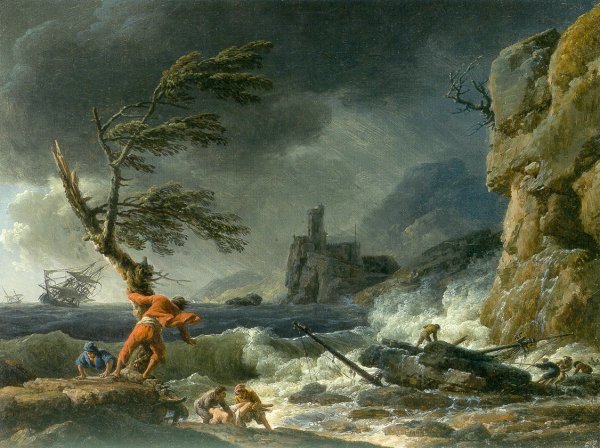Naufragios
XXII
Cabeza de Vaca

The Malhado Way of Life
THE PEOPLE we came to know there [Capoques and Han, as identified later in the narrative] are tall and well-built. Their only weapons are bows and arrows, which they use with great dexterity. The men bore through one of their nipples, some both, and insert a joint of cane two and a half palms long by two fingers thick. They also bore their lower lip and wear a piece of cane in it half a finger in diameter.
Their women toil incessantly.
From October to the end of February every year, which is the season these Indians live on the island, they subsist on the roots I have mentioned, which the women get from under water in November and December. Only in these two months, too, do they take fish in their cane weirs. When the fish is consumed, the roots furnish the one staple. At the end of February the islanders go into other parts to seek sustenance, for then the root is beginning to grow and is not edible.
These people love their offspring more than any in the world and treat them very mildly.
If a son dies, the whole village joins the parents and kindred in weeping. The parents set off the wails each day before dawn, again at noon, and at sunset, for one year. The funeral rites occur when the year of mourning is up. Following these rites, the survivors wash off the smoke stain of the ceremony in a symbolic purgation. All the dead are lamented this way except the aged, who merit no regrets. The dead are buried, except medicine-men, who are cremated. Everybody in the village dances and makes merry while the pyre of a medicine-man kindles, and until his bones become powder. A year later, when his rites are celebrated, the entire village again participating, this powder is presented in water for the relatives to drink.
Each man has an acknowledged wife, except the medicine-men, who may have two or three wives apiece. The several wives live together in perfect amity.
When a daughter marries, she must take everything her husband kills in hunting or catches in fishing to the house of her father, without daring to eat or to withhold any part of it, and the husband gets provided by female carrier from his father-in-law's house. Neither the bride's father nor mother may enter the son-in-law's house after the marriage, nor he theirs; and this holds for the children of the respective couples. If a man and his in-laws should chance to be walking so they would meet, they turn silently aside from each other and go a crossbow-shot out of their way, averting their glance to the ground. The woman, however, is free to fraternize with the parents and relatives of her husband. These marriage customs prevail for more than fifty leagues inland from the island.
At a house where a son or brother may die, no one goes out for food for three months, the neighbors and other relatives providing what is eaten. Because of this custom, which the Indians literally would not break to save their lives, great hunger reigned in most houses while we resided there, it being a time of repeated deaths. Those who sought food worked hard, but they could get little in that severe season. That is why the Indians who kept me left the island by canoe for oyster bays on the main.
Three months out of every year they eat nothing but oysters and drink very bad water. Wood is scarce; mosquitoes, plentiful. The houses are made of mats; their floors consist of masses of oyster shells. The natives sleep on these shells--in animal skins, those who happen to own such.
Many a time I would have to go three days without eating, as would the natives. I thought it impossible that life could be so prolonged in such protracted hunger; though afterwards I found myself in yet greater want, as shall be seen.
The [Han] Indians who had Alonso del Castillo, Andrés Dorantes, and the others of their barge who remained alive, spoke a different dialect and claimed a different descent from these I lived among. They frequented the opposite shore of the main to eat oysters, staying till the first of April, then returning.
The distance to the main is two leagues at the widest part of the channel. The island itself, which supports the two tribes commodiously, is half a league wide by five long. [Whether computing by the 2.6 or the 3.1-mile league, this is a fairly accurate estimate of the actual 1.8-mile average width of Galveston Island and the 5.4-mile maximum distance from the mainland; but the treetop estimate of the length is only about half the island's actual 29.6-mile extent.]
The inhabitants of all these parts go naked, except that the women cover some part of their persons with a wool that grows on trees [Spanish moss], and damsels dress in deerskin.
The people are generous to each other with what little they have. There is no chief. All belonging to the same lineage keep together. They speak two languages: Capoque and Han.
They have a strange custom when acquaintances [distantly separated?] meet or occasionally visit, of weeping for half an hour before they speak. This over, the one who is visited rises and gives his visitor all he has. The latter accepts it and, after a while, carries it away, often without a word. They have other strange customs, but I have told the principal and most remarkable of them. [These last six paragraphs have been transposed from the succeeding chapter.]
In April [1529] we went to the seashore and ate blackberries all month, a time of areitos [dance ceremonies] and fiestas among the Indians.